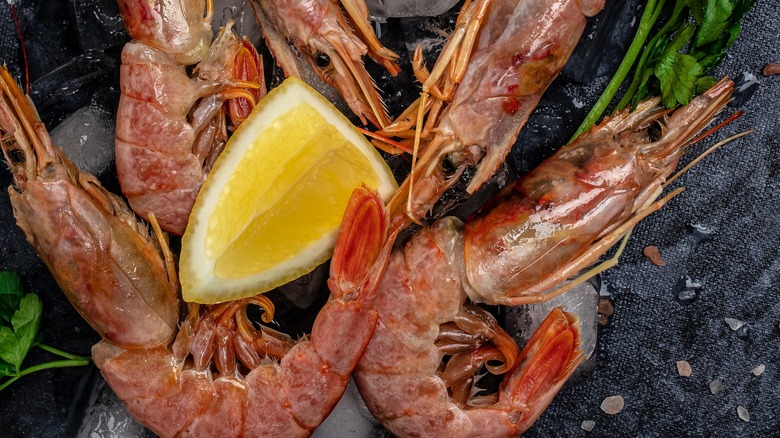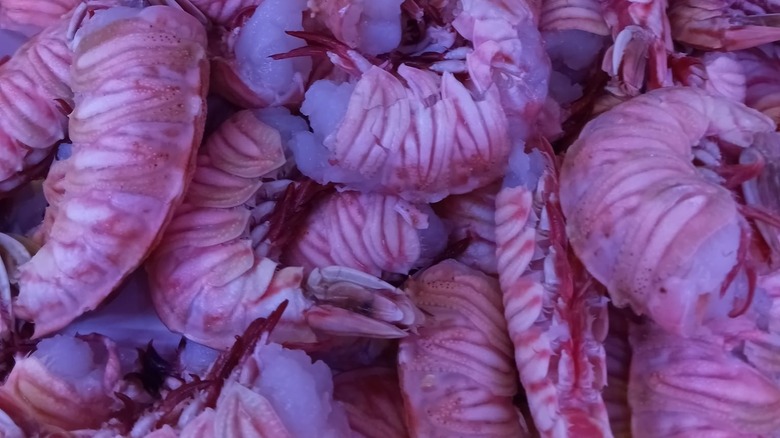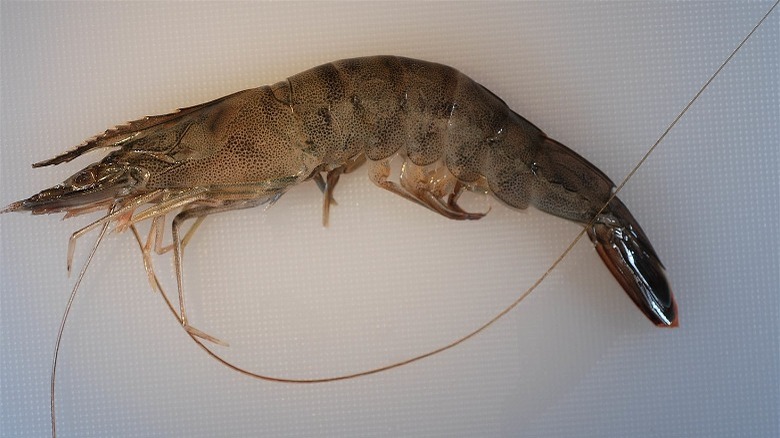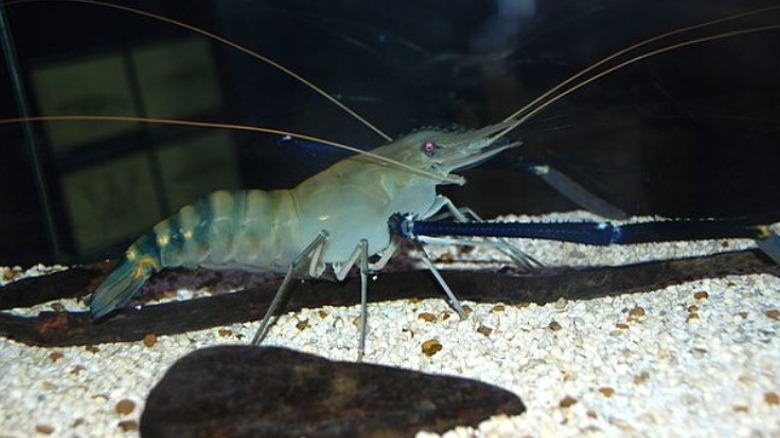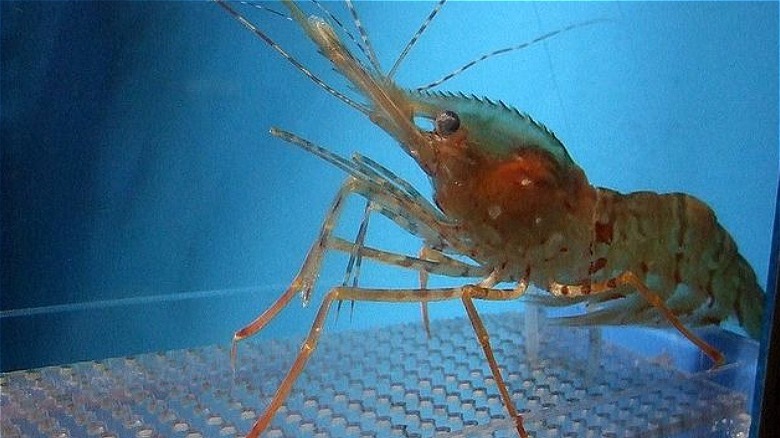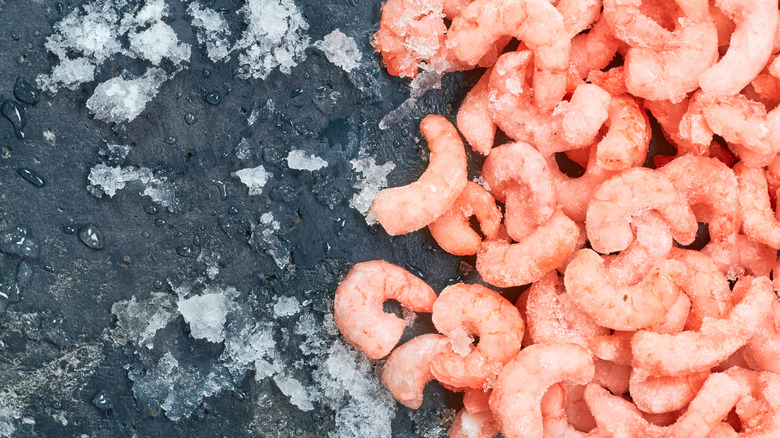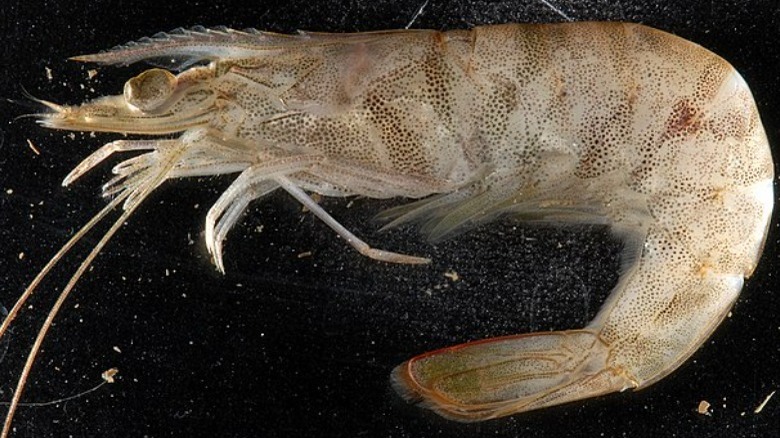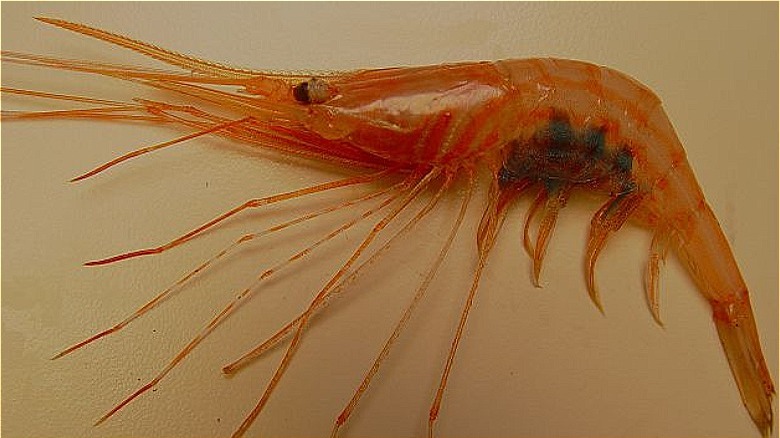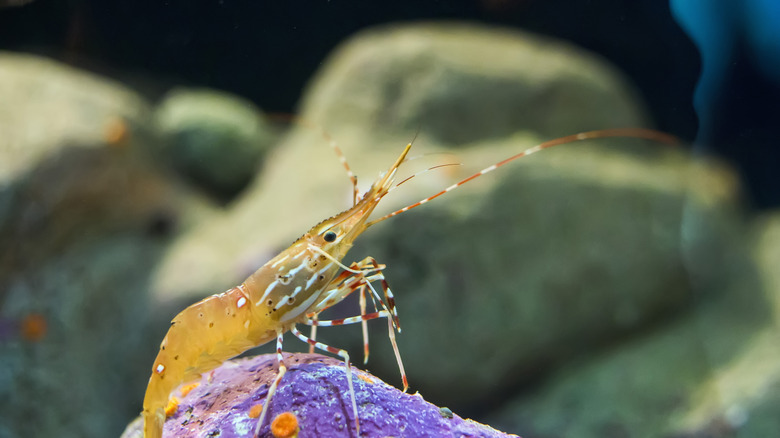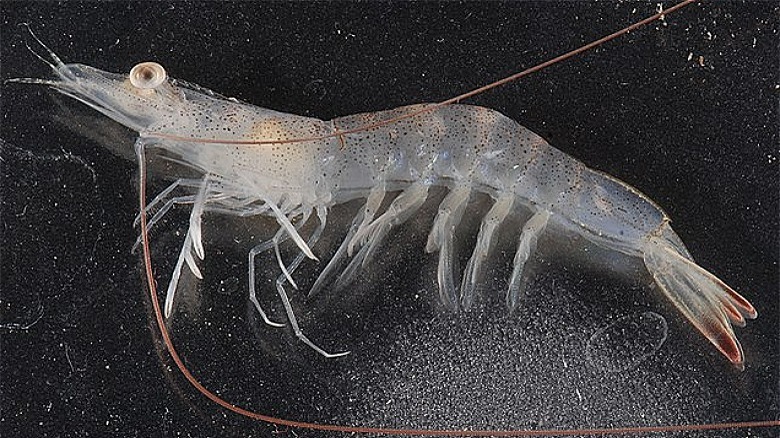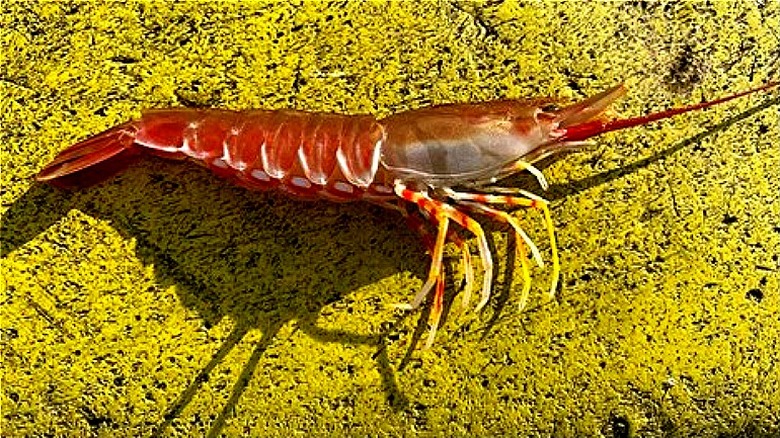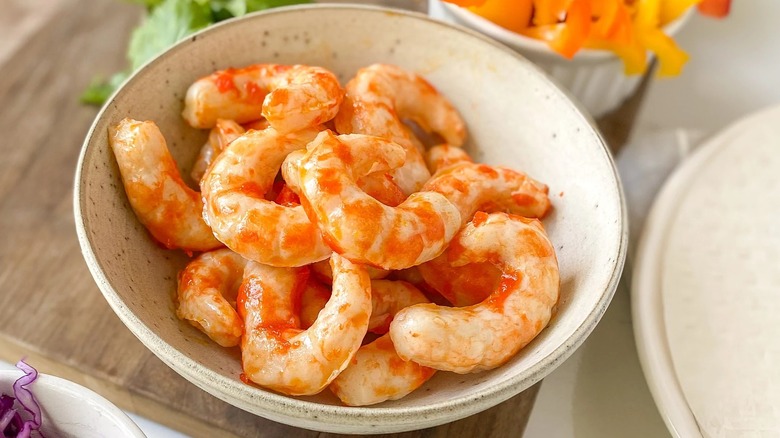12 Types Of Shrimp Explained
Shrimp have long occupied the aqueous globe, with species dating back 190 million years (via Nature). A tasty source of food for whales, seabirds, and humans alike, shrimp have so successfully adapted to life on Earth that they comprise upwards of 3,500 species. Around 300 of these are consumed by humans. Shunned as low-nutrition trash food for centuries, shrimp began their meteoric rise to the top of the food chain in the late 20th century, becoming the nation's most consumed seafood by 2001.
Despite the delectable flavor of wild-caught U.S. varieties, 90% of the shrimp consumed by the nation is imported from Asia and Latin America, both of which can significantly undercut U.S. prices and have developed seafood industries marked with human rights abuses, environmental degradation, and disease spread (via Civil Eats and Science Advances). As a result, U.S. fisheries and shrimp farmers have been working to create regulations, technologies, and best practices to protect the American seafood industry from such pitfalls. At the same time, fishmongers are increasingly narrowing their sources to those that practice sustainable harvesting and farming methods (see Monterey Fish Market).
The next time you prepare a shrimp recipe, consider the species found below which are either rated as sustainable wild catch by the National Oceanic and Atmospheric Administration's (NOAA) FishWatch or are farmed in the United States according to the best aquaculture practices as stipulated by the Monterey Bay Aquarium's Seafood Watch.
Brown rock shrimp
This tiny species (sicyonia brevirostris, via NOAA) inhabits the southern Atlantic and Gulf coasts. According to Wild Ocean Seafood, rock shrimp were considered "trash fish" until the 1960s and were tossed overboard because they were too difficult to peel. All that changed, however, after fisherman Rodney Thompson invented a device that could split rock shrimp shells, allowing easy access to the meat. Today, rock shrimp are often sold butterflied and deveined (with the intestinal tract removed) and are available with the shell attached or peeled. As with all shrimp, they are also sold live, frozen, unpeeled, head-on, and head-off.
According to Chef's Resources, rock shrimp max out at six inches, so a large-sized catch numbers 21-25 count. As with all shrimp, they should have a delicate marine aroma. Avoid any with a whiff of ammonia or a fishy smell. When choosing frozen shrimp, look for ones that have been individually quick-frozen (labeled IQF), which is the preferred method for freezing wild-caught shrimp on board the ship (via Lobster Anywhere).
Because rock shrimp inhabit deep, cold waters, their meat has a texture similar to lobster according to Capt. Anderson's, but with a sweet briny flavor that some compare to spiny lobster or Dungeness crab. They are suited for almost any shrimp recipe that requires cooking and stand up well to grilling, broiling, or boiling. One of the most popular ways to prepare rock shrimp is to fry them, and they star in dishes ranging from thick-battered popcorn shrimp to lightly coated tempura.
Brown shrimp
Also known as "brownies," brown shrimp are a warm water species (farfantepenaeus aztecus, via NOAA) that inhabit the waters off the Atlantic coast and the Gulf of Mexico. According to a study out of Texas A&M, the flavor of each of the major Gulf shrimp species — brown, pink, and white— varies according to their preferred habitat. Brownies' unique flavor derives from a compound found in vegetation that proliferates in warm muddy ocean waters, namely, bromophenol. The comparatively higher bromophenol levels found in the muscle tissue of brownies provide the mineral flavor that distinguishes them from their white and pink cousins, both of which prefer colder sandy sea bottoms. The more bromophenol-rich a shrimp's diet, the more it exhibits an ocean-like or umami-rich flavor.
Like most shrimp, brownies are often sold head-off. As Stuart Farrimond explains in "The Science of Cooking," shrimp heads contain a gland that creates digestive enzymes. After a shrimp dies, these enzymes leak into the flesh and can begin to break it down within hours. Shrimp that are not kept alive or immediately frozen aboard the ship should have their heads removed as soon as possible.
When cooked, brownies turn a sunset orange and are considered the most robustly flavored of the Southeastern Atlantic and Gulf Coast shrimp species, noted for a murky, tangy flavor and firm texture. They work especially well in highly flavored dishes such as gumbos, curries, and creole sauces.
Giant freshwater prawns
Also known as Malaysian tiger prawns or giant river prawns, macrobrachium rosenbergii (via the Food and Agriculture Organization of the United Nations) are farmed throughout the world, with Hawaii founding the U.S. industry in the 1960s (via FishSite). Prawns typically inhabit freshwater and belong to a different suborder (dendrobranchiata) of crustaceans than shrimp (pleocyemata), although the terms are often muddled. Among the distinctions are the gills and body structures of the distinct suborders, with prawns having straighter bodies and longer legs. In the United States, large shrimp are typically referred to as prawns (via MasterClass).
Most imported farmed shrimp are raised in densely populated and polluted waters that, like concentrated animal farming operations (CAFO), resort to antibiotics to prevent disease outbreaks among creatures raised in densely packed conditions (via FoodPrint). According to SeafoodWatch, the most sustainably farmed giant prawns are raised in indoor recycled water systems (RWS). The latest USDA aquaculture survey, completed in 2018, documented 11 farms across five states raising freshwater prawns for culinary purposes (via Agricultural Marketing Resource Center). These prawns are prized for having a large amount of meat and thin shells and are generally harvested when they reach six to seven inches in length. Head-on prawns can be slit in half lengthwise and grilled shell-down until the meat turns from translucent to white and the orange-colored oil contained in the head takes on the consistency of chilled butter.
Humpback shrimp
Known in Japan as Toyama shrimp, humpback shrimp (or pandalus hypsinotus) reach up to seven inches in length, making them the largest of the three coonstripe species, which also include dock and humpy (via Alaska Department of Fish & Game and Washington State Fish and Wildlife). Humpbacks received their name because of the prominent ridge that extends along their heads. Some shrimp connoisseurs consider them even sweeter, more delicate tasting than spot and sidestriped shrimp. Both farmed and wild-caught humpback shrimp are often found on menus at Japanese restaurants specializing in sushi and sashimi (via Sushipedia). As with most farm-raised shrimp, the meat typically tastes milder than that of wild-caught. Sometimes the flesh of farmed may be firmer.
According to Harold McGee in "On Food and Cooking," all crustaceans, including humpbacks, contain enzymes in the muscles that turn the flesh mushy when it reaches between 130 and 140 F. The enzymes can be rapidly inactivated by heating shrimp quickly to a temperature above 140 F. Or, to maximize moisture, sushi-grade shrimp can be heated to between 130 and 140 F and consumed immediately. Like all shrimp, wild-caught and farmed humpback are tastiest when cooked in the shell, as the carapace (including the head) not only keeps the flavors from escaping but also imparts its own sugars and proteins to the exterior of the flesh.
Ocean shrimp
Also known as Pacific pink or smooth pink shrimp, pandanus jordani (via FishChoice) inhabit the muddy bottoms of the Pacific Coast from southern Alaska to northern California (via Fish Source). Averaging a harvest of 20 million pounds a year in Oregon, the state's pink shrimp industry claims the distinction of being the first certified sustainable fishery in the world (via Marine Stewardship Council).
Weighing in at 80 to 250-count per pound, these tiny shrimp are typically sold shelled and deveined. When recipes call for salad shrimp or bay shrimp, Pacific pinks make for a fine choice. As with most cold-water species of shrimp, ocean shrimp benefit from a quick brine (3 to 5% salt) if cooked using dry heat, as the brine stops them from becoming mushy when cooked. Dry heat methods include grilling, roasting, frying, stir-frying, or baking. No brine is recommended if cooking in liquid, per What's Cooking America. Slow cooking will turn the flesh mushy, so pick recipes that call for quick cooking at a high temperature.
Pacific white shrimp
A common species of shrimp farmed in the United States, Pacific white shrimp (litopenaeus vannamei via Seafood Watch) are also wild-caught in their native habitat spanning the warm waters of Mexico down to Peru. Unlike the wild-caught Pacific whites — most of which are frozen aboard ships — farm-raised whites can be shipped direct (never frozen) from an aquaculture company, several of which are in the landlocked Midwest. According to SeafoodWatch, much of the Pacific white shrimp sold in the United States comes from Mexico, Nicaragua, India, Malaysia, and China, countries which are more likely to use unsustainable harvesting and farming methods.
U.S. farmed litopenaeus vannamei have undergone genetic breeding for decades in order to make them more disease-resistant for aquaculture. According to SeafoodSource, aquaculture is primed to take off in the United States as soon as the price of sustainable technologies sees a significant drop. The two shrimp farming methods listed as "Best Choice" by SeafoodWatch are recirculating tanks, which treat and recycle water that flows through raceways and uses a steady stream to flush out impurities within the habitat. Farmed white shrimp will be milder in flavor than wild-caught, a characteristic many Americans have grown to prefer.
Pink shrimp
The tender, sweet flesh of pink shrimp (farfantepenaeus duorarum via Journal of Crustacean Biology) is similar to that of Gulf whites. Also called Atlantic pinks, hoppers, and Gulf shrimp, this species has been known to reach upwards of 11 inches in length. As Barton Seaver notes in "American Seafood," pink and brown shrimp are both nocturnal and inhabit deeper waters than their white-fleshed cousins. Because pinks, like brownies, swim alongside small fish, harvests can result in significant bycatch — the term used to describe creatures that are accidentally caught by fisheries that trawl for a specific harvest, including sea turtles (via NOAA). According to Paul Greenberg's exposé "American Catch," the United States has innovated trawling and trapping systems that have cut bycatch in half, and, as of 1987, turtle excluder devices (TEDs) have been required on shrimping gear. In addition, fishermen and fisheries are working to educate chefs, restaurateurs, and the general public about the value of bycatch, which they have begun to sell at market or via community-supported fisheries (via Local Catch). Previously, bycatch had been simply tossed overboard.
Among the Gulf shrimp, pinks are considered the sweetest and most delicate but are often used interchangeably with whites. Because pinks are the largest of the commercial warm-water species, they typically boast more meat, making them a prime choice for family-style peel-and-eat shrimp boils. They are also delicious when grilled or broiled head-on.
Royal red shrimp
Royal reds (pleoticus robustus via Sea Life Base) get their name due to their bright red shells and are valued for their sweet, salty flavor and tender texture, which is often compared to that of lobster and bay scallops. Deep sea creatures, royal reds inhabit waters 500 to 2400 feet deep off the Atlantic Coast and Gulf of Mexico, where they seek cool waters averaging about 50 F (see "Deep Sea Trawl Fisheries" by Oceana). The species can be found as far north as New England, where they are called Stonington reds.
Because royal reds, also known as cardinals, inhabit deep sea territory, they are some of the most prized and expensive shrimp available. Especially perishable, royal reds must be individually quick-frozen at sea. The upside, however, is that the need to quick-freeze them means that they are often sold head-on. On his blog Honest Food, Hank Shaw recommends using them for aguachile (a quick-marinated version of ceviche), risotto, shrimp and grits, or a simple sauté. Their shells also make an especially flavorful stock.
Spot shrimp
Found off the Pacific Coast from Southern California up to Alaska as well as in waters off Hawaii, Japan, and Korea, spot shrimp (pandalus platyceros via Alaska Department of Fish & Game) boast sexually fluid lives — a sex-changing spot shrimp will spawn as a male and, depending on how long it lives, transform into a female that will lay and fertilize eggs at depths up to 700 feet. Living up to eleven years, they are named for the distinguishing white spots on their first and fifth abdominal segments and boast a carapace that leans reddish brown or reddish tan. They can grow up to ten inches in length (via the National Library of Medicine).
Spot shrimp turn bright pink when cooked and are prized for their delicate, sweet flesh. They can be fully cooked in one to two minutes, but are often eaten raw. Japanese, in particular, rely on spot shrimp for sashimi. They are wild-caught off the coasts of the United States and Japan, where regulations protect their coastal habitat (see Monterey Bay Aquarium). Because they are sustainably harvested in both countries, they are not only ideal for sashimi but also for ceviche. On his wild food blog, chef Hank Shaw recommends sautéing spot shrimp head-on in the shell with olive oil, garlic, lemon, and parsley. The heads can be sucked like crawfish, reserved for stock, or deep-fried and eaten as a snack.
White shrimp
Also known as Gulf whites, white shrimp (litopenaeus setiferus via FishChoice) were the first commercial shrimp sold in Louisiana, dating back to 1709. Found along the Atlantic from New York to Florida and within the Gulf of Mexico, they remain one of the most prized catches to this day, likely because of their heritage as the founding species of the Gulf Coast shrimping industry. Caught primarily off the coasts of Louisiana and Texas, 110 million pounds of Gulf white shrimp were harvested in 2020 (via NOAA).
As their name suggests, the shrimp's flesh turns from translucent to white when cooked. They are considered the cleanest-tasting of the three Southern Atlantic and Gulf Coast species that make up the vast majority of wild-caught shrimp. Because of their warm water habitat, white shrimp tend to disintegrate less rapidly than cold water shrimp (per McGee "On Food and Cooking"). All warm water shrimp tend to absorb the flavors of the ingredients in which they are cooked. The clean taste of Gulf whites makes them especially well-suited to showcasing robustly flavored dishes such as gumbo, shrimp creole, barbecue shrimp, or Asian and Caribbean curry sauces. They are also prized for shrimp boils.
Ridgeback prawns
The only rock shrimp to inhabit the Pacific coastal waters off of the United States, ridgeback prawns (sicyonia ingestis via Latin American Journal of Aquatic Research) are technically a prawn as they broadcast their eggs in the water rather than carrying them on their legs. Occupying Pacific waters from Monterey down to northern Mexico, ridgeback prawns became a part of California's commercial fishing industry in the 1970s. They are harvested from San Diego north to Santa Barbara, with most found in the Santa Barbara Channel (see California Marine Life Portal).
They can be easily identified by the prominent ridge that extends along their upper backs. Like their Atlantic rock shrimp cousins, ridgebacks tend to become mushy faster than their warm-water relatives, so they should be prepared and eaten quickly after purchase. They have a crab-like delicacy, much revered by chefs and home cooks alike. In his debut cookbook "Manresa: An Edible Reflection," three-star Michelin chef David Kinch recommends pan-searing the prawns in butter, deglazing with brandy, and adding crushed peppercorns and salt (via 7x7).
Mind Blown Shrimp
For those seeking alternatives to wild and farmed shrimp, vegan options abound. Hoping to follow the 21st-century success of wildly popular plant-based meat brands such as Impossible and Beyond, several U.S. companies have developed new vegan seafood products. Made by The Plant Based Seafood Co., Mind Blown coconut shrimp was named the "Most Disruptive Product of 2020" by Prepared Foods, an industry publication that covers research and development within the manufactured food and beverage industry. The verisimilitude of Mind Blown shrimp to seafood has also drawn investors such as Top Chef co-host Tom Colicchio.
Like other brands, Mind Blown shrimp is made with konjac powder, a fiber extracted from the tropical elephant foot yam that gives it a snappy shrimp-like texture and firm bite. They are currently available online and in grocery stores around the country. The coconut version has a distinctive sweet flavor and firm texture, making it suitable for pan-sautéeing or adding to vegetable stews, per a recent podcast episode of Fish Talk. For those wanting a more savory version, the pre-breaded dusted shrimp are suitable for pan-frying, deep-frying, and air-frying.
